


Synthesis of phosphorus tribromide
Phosphorus halides are very reactive chemicals, which can be used for many interesting demonstration experiments and which also are very useful for synthetic purposes. They are capable of replacing hydroxyl groups by halogen atoms in a wide range of compounds, such as alcohols and carboxylic acids. Unfortunately, phosphorus halides are very hard to obtain for the home chemist, due to their highly corrosive and toxic nature.
In this experiment, a procedure is presented, which can be used to make phosphorus tribromide from bromine and red phosphorus in acceptable yield. The procedure only requires the use of very simple equipment. As a consequence, one should accept somewhat higher losses. During the procedure huge amounts of toxic and corrosive vapors are produced, so this experiment MUST be done outside or in a good fume hood.
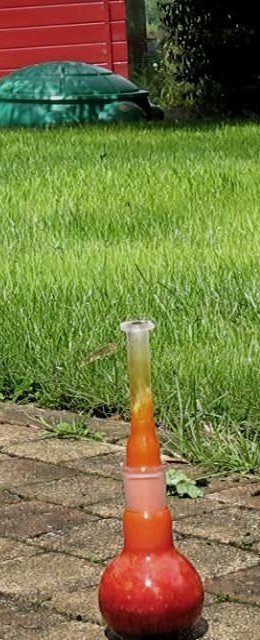
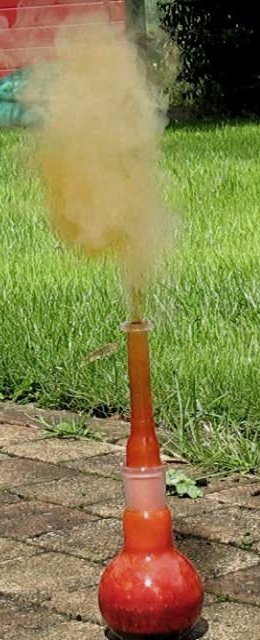
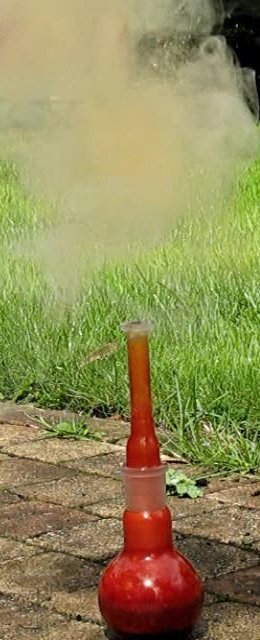
The three pictures above show the result of adding a small amount of red phosphorus to the reaction mix in the flask. Each time when some phosphorus is added, a plume of bromine vapor and vapor of phosphorus bromide is ejected from the flask.
The final yield is approximately ⅔ of theory, based on the amount of bromine used. Most of the losses are due to the big plumes of fumes ejected from the flask after each addition of some phosphorus.
![]()
![]() Required
chemicals:
Required
chemicals:
-
bromine
-
red phosphorus
-
bleach (for cleanup)
![]() Required
equipment:
Required
equipment:
-
flask with a long neck
-
small distillation setup
-
heating mantle
-
thermometer which includes the range from 100 °C to 200 °C
![]() Safety:
Safety:
-
red phosphorus is very flammable
-
bromine is very corrosive and contact with the skin must be avoided and the vapor should not be inhaled
-
the fumes, produced in the experiment, are very corrosive and inhalation of these fumes should be avoided
-
the final product, phosphorus tribromide, is very corrosive and very toxic.
The intensely corrosive fumes, produced in this experiment, are so dense and so copious that in practice this experiment only can be conducted outside on a breezy day.
![]() Disposal:
Disposal:
-
Remains of unreacted phosphorus and crusts of phosphorus pentabromide, sticking to the glass, should be rinsed with standard household bleach, until all of the material has dissolved. This rinsing should be done outside or at least in a very well ventilated room. Keep rinsing until all of the phosphorus and crusts have dissolved. This may take a few minutes.
-
The resulting waste is not particularly toxic (it is mainly phosphate and chlorine/bromine based). Remaining liquid waste can be flushed down the drain with a lot of water.
![]()
Performing the synthesis
![]() Pour approximately 20 ml of bromine in a 100 ml flask with a
long neck. An even better option is to use a flask to which a long tube can be
connected.
Pour approximately 20 ml of bromine in a 100 ml flask with a
long neck. An even better option is to use a flask to which a long tube can be
connected.
![]() Take approximately 10 grams of red phosphorus and put this
aside. This is an excess amount of phosphorus. If insufficient phosphorus is
used, then the final product will be impure and will contain phosphorus
pentabromide.
Take approximately 10 grams of red phosphorus and put this
aside. This is an excess amount of phosphorus. If insufficient phosphorus is
used, then the final product will be impure and will contain phosphorus
pentabromide.
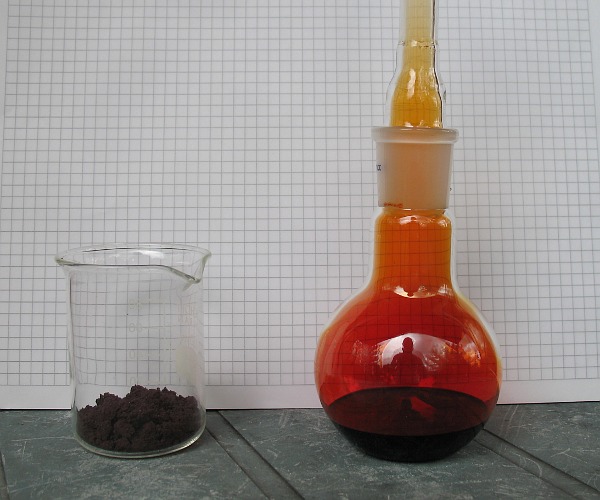
The quantities used are not critical, a deviation of 10% or so is not a problem. At the end of the synthesis all phosphorus is added to the bromine and quite a lot of it remains unreacted.
![]() Add the
phosphorus to the bromine in small amounts. Initially, not more than a small
heap on the tip of a screwdriver should be added. In the later stages of the
experiment somewhat larger amounts of phosphorus can be added safely.
Add the
phosphorus to the bromine in small amounts. Initially, not more than a small
heap on the tip of a screwdriver should be added. In the later stages of the
experiment somewhat larger amounts of phosphorus can be added safely.
When a small amount of phosphorus is added, then a dark red mud is formed and also a lot of a bright red crust is formed, which sticks to the glass. This looks as follows:
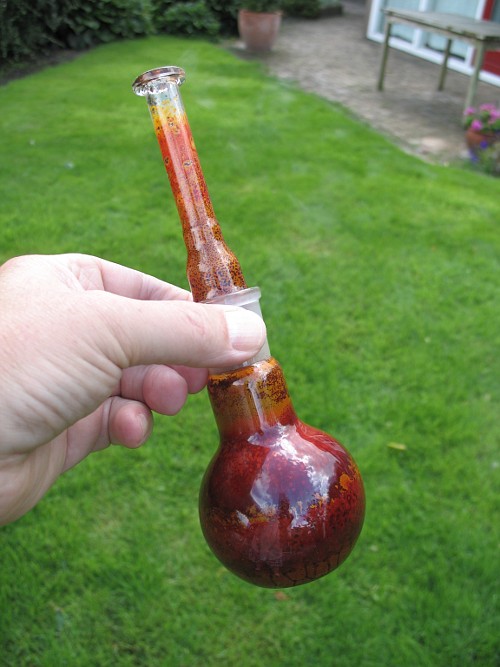
The second half of the phosphorus can be added more quickly and there is less need to keep the long neck on the flask. Still quite some fume is produced when phosphorus is added, but the reaction is less vigorous. The following four pictures show the effect of adding a big spatula full of phosphorus to the flask without the long tube attached to it.


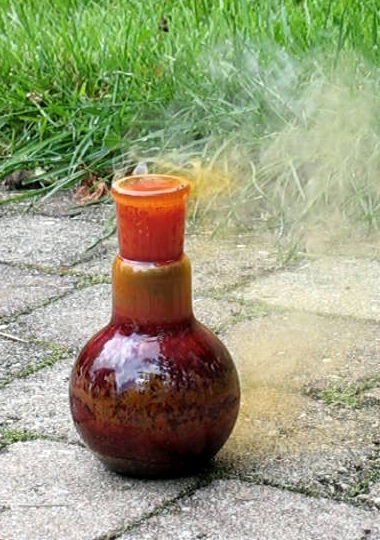
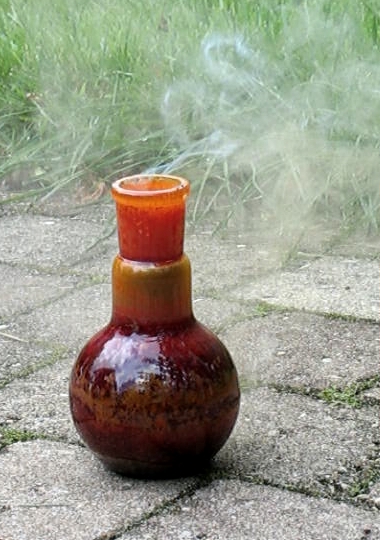
In this stage of the process it is good to pick up the flask after a few additions of phosphorus and swirl its contents gently. Although the reaction is very violent, the flask does not become so hot that it cannot be picked up with your hands. Just do not hold it at the bottom part, which contains the liquid.
![]() When much more phosphorus is added (around 80% of all
phosphorus), then the material in the flask becomes more liquid again and in the
bottom part the red color disappears. The picture below shows the flask with the
bottom half filled with a colorless liquid in which the excess red phosphorus is
suspended.
When much more phosphorus is added (around 80% of all
phosphorus), then the material in the flask becomes more liquid again and in the
bottom part the red color disappears. The picture below shows the flask with the
bottom half filled with a colorless liquid in which the excess red phosphorus is
suspended.
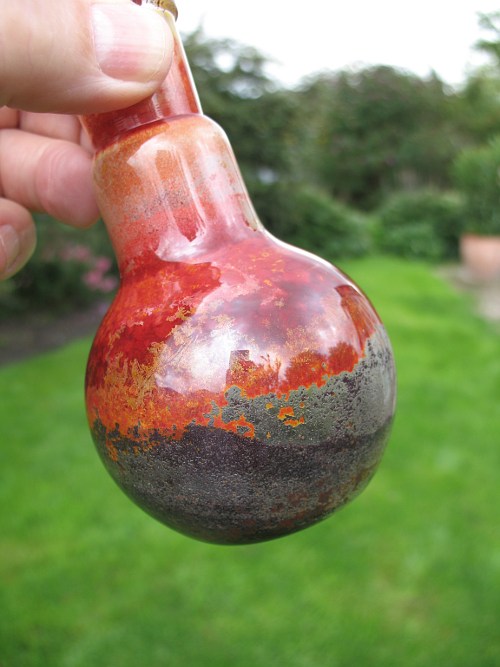
Add all remaining phosphorus, but keep one big spatula full of it for the work up of the material.
A few videos were made of the violent reaction between the red phosphorus and the bromine:
- initial adding of phosphorus (download size 1.6 MByte).
- intermediate adding of phosphorus (download size 5.1 MByte).
- adding phosphorus near the end of the process (download size 7.8 MByte).
![]()
Isolation and purification of the material
Further processing of the material can be done inside, but still very good ventilation is needed. So, keep windows open and allow a good breeze to pass through the room!
![]() Put the flask with the long tube attached in a heating mantle
and set this heating mantle to low heat, such that the liquid in the flask just
starts simmering. You can see the liquid condensing at the glass again and then
it starts refluxing. While it refluxes, it dissolves most of the red crust,
which sticks to the glass and this runs back into the boiling liquid. This
liquid reacts with the excess phosphorus, suspended in the liquid.
Put the flask with the long tube attached in a heating mantle
and set this heating mantle to low heat, such that the liquid in the flask just
starts simmering. You can see the liquid condensing at the glass again and then
it starts refluxing. While it refluxes, it dissolves most of the red crust,
which sticks to the glass and this runs back into the boiling liquid. This
liquid reacts with the excess phosphorus, suspended in the liquid.
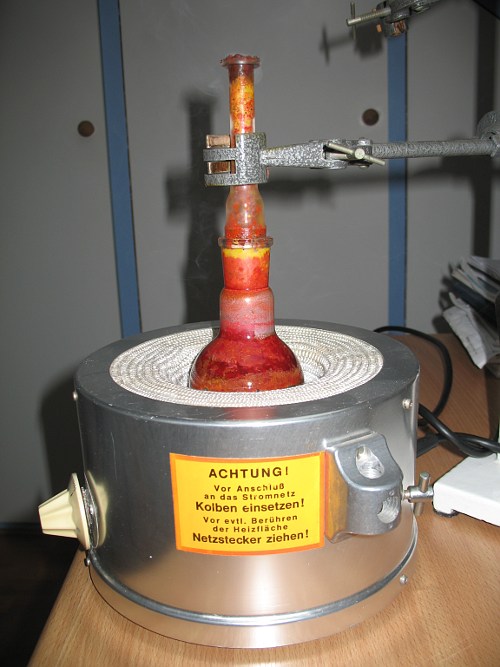
If the boiling becomes too fast, then immediately take the flask from the heating mantle (use a heat resistant clamp, do not take it in your hand) and stopper it. Copious amounts of fumes will be produced if the vapor escapes from the long tube! Do this refluxing in a very well ventilated room, because quite some fumes are produced anyway when the liquid is heated. After this step, the flask looks as follows:
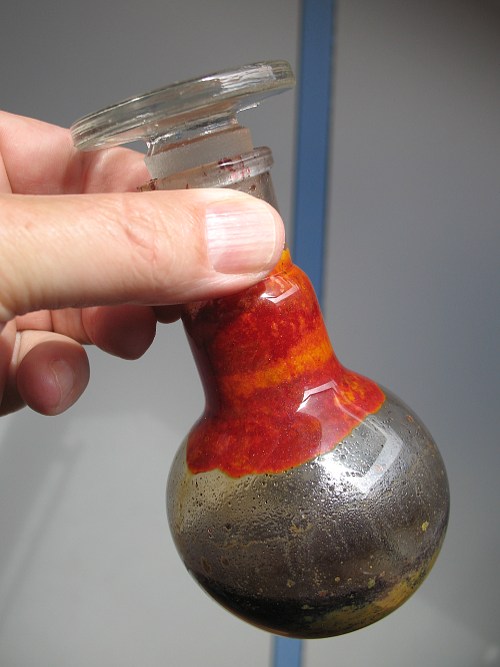
Still some red crust sticks to the glass. Stopper the flask very well with a ground joint and shake the flask. Slowly the red crust dissolves in the liquid. When the liquid is cold, this takes tens of minutes. By carefully heating the glass at the place of the crust, the dissolving process goes much faster, but the flask must be capable of withstanding local heating of the neck, otherwise you just have to be patient!
The refluxing step may be skipped (and if the ventilation in your room is not that good, then this step should be skipped). If the refluxing step is skipped, then much more time must be taken for dissolving the red crust. One also can choose to leave the crust as is, but then you'll suffer at least a 10% additional loss.
![]() Put a
spatula of red phosphorus in a 50 ml round bottom flask and then pour the liquid
from the 100 ml flask into the 50 ml round bottom flask.
Put a
spatula of red phosphorus in a 50 ml round bottom flask and then pour the liquid
from the 100 ml flask into the 50 ml round bottom flask.
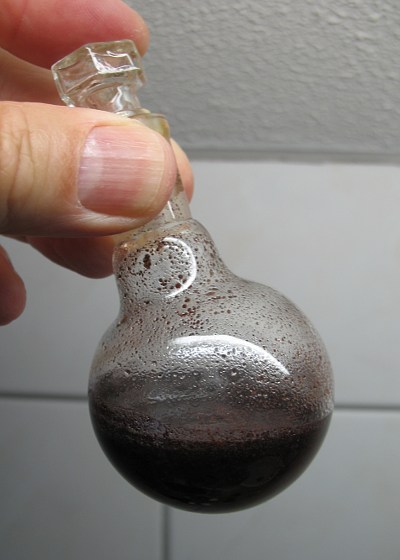
The result is a dark liquid (with red phosphorus and darker allotropes of phosphorus suspended in the liquid).
![]() Slowly
distill the liquid using a small distillation setup for 50 ml flasks. If the
distilling is done slowly, then no water cooling is needed, the phosphorus
tribromide quickly condenses in a long tube. The distillation setup must be all
glass and a safety tube must be connected such that fumes can be vented outside.
Slowly
distill the liquid using a small distillation setup for 50 ml flasks. If the
distilling is done slowly, then no water cooling is needed, the phosphorus
tribromide quickly condenses in a long tube. The distillation setup must be all
glass and a safety tube must be connected such that fumes can be vented outside.
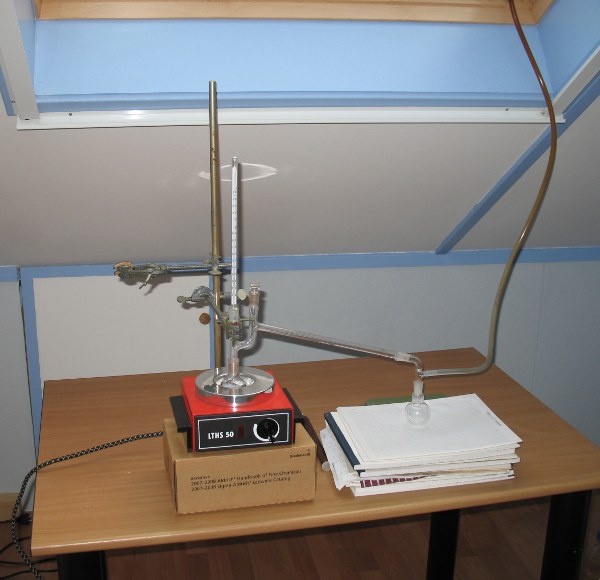
A close-up of the setup is shown below:
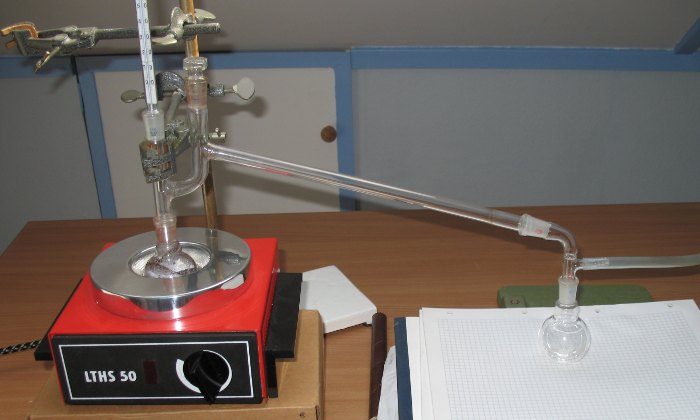
The thermometer must be in the range 100 ... 200 °C.
The liquid slowly collects in the receiving flask. Initially, the liquid has a fairly strong yellow color. After collecting one ml or so, switch off the heating mantle and wait till distillation stops and then pour the liquid back into the heated flask. The yellow color most likely is due to the presence of bromine, which may come from the joints, or maybe from something inside the glassware. By simply returning this into the flask with the suspension of red phosphorus it all is destroyed. After this initial step, restart the distillation and allow all of the liquid to come over.
The thermometer readout at the start of the distillation process was between 168 and 169 °C.
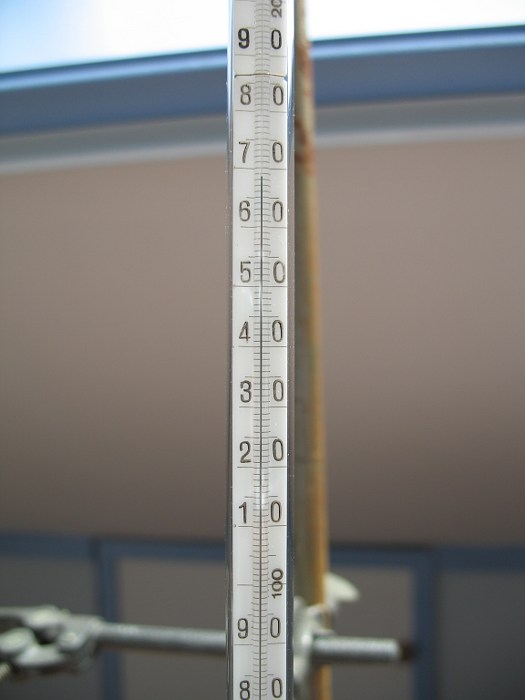
During the distillation process, the readout slowly increased to just over 172 °C. At that point, the heated flask was almost dry and the heating mantle was switched off. The final remains of the liquid were driven off by the remaining heat of the heating mantle.
Two videos are made of the distilling process:
- Boiling and refluxing of liquid in heating mantle (download size 1.9 MByte).
- Collecting of product in receiving flask (download size 0.8 MByte).
![]()
The final product
The final product is a very pale yellow liquid and it also is slightly turbid.

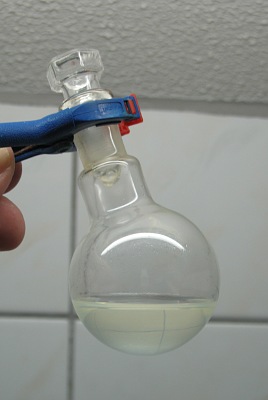
The total volume of liquid is approximately 17 ml.
Some properties of the liquid
The liquid is slightly turbid. It is not clear what causes the turbidity.
When a small quantity of the liquid is added to a large excess amount of water, then a blob of liquid is formed at the bottom. This blob of liquid does not react violently, it slowly dissolves in the water. The reaction with water is exothermic. After a few minutes the water around the blob of phosphorus tribromide has heated up noticeably, but it is not hot.
The liquid heavily fumes when in contact with air and it has a very pungent odor.
![]()
Discussion of results
In this synthesis the direct reaction between bromine and red phosphorus is used to first make phosphorus pentabromide, which by adding more phosphorus is fully converted to phosphorus tribromide. Phosphorus pentabromide is not a fully stable entity, it exists in equilibrium with phosphorus tribromide and elementary bromine.
Initially: 2P + 5Br2 → 2PBr5
The following equilibrium exists: PBr5 ↔ PBr3 + Br2
When more red phosphorus is added, then the equilibrium is forced to the right, because the bromine is taken away by the red phosphorus. Finally, all bromine is converted to PBr3. Heating and shaking is needed to have all PBr5 converted to PBr3. The optional reflux step speeds up this process considerably.
Determination of final yield (based on amount of bromine)
Bromine was taken from a 20 ml ampoule, which however was not fully filled to its marker line, it probably contained only 18 or 19 ml of bromine. Given the density of bromine of 3.1 gram per ml, it is assumed that the experiment was started with 60 grams of bromine.
The total amount of phosphorus tribromide is 17 ml. At a density of 2.85 gram per ml this makes up for 48.5 grams of phosphorus tribromide and this contains 43 grams of bromine. Total yield is almost 72%.
Even with the uncertainties and the coarse measurements of volumes it can be stated that the total yield certainly is ⅔ of theory, but probably it is slightly better. Approximately 30% of all bromine is lost in the copious fumes and also some bromine is lost in crusts of phosphorus pentabromide which were not recovered from the glass tube.